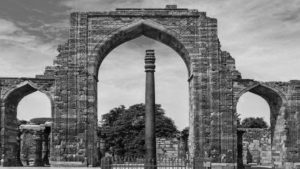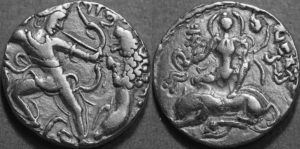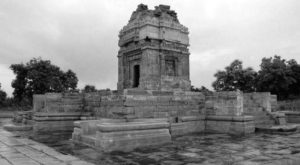The Tradition of Kshatra in India: The Awe-Inspiring Gupta Style
An entire galaxy of eminences in Astronomy such as Brahmagupta, Varahamihira, Aryabhata and Bhaskara I belonged to the Gupta Era. A major benefit that ensued as a result of the advancement in Astronomy was the ease in and flourishing of maritime trade and commerce. Predicting rain and harvest became more accurate. It was an era when the Mariner’s Compass had not yet been invented. It was perhaps the invention of the Chinese. When Marco Polo visited China in the twelfth or the thirteenth century, he first laid his eyes upon the Mariner’s Compass. Back in those days when people travelled at night, they discerned direction on the basis of stars.
But there is one aspect that still surprises and saddens me. Our people had made truly remarkable accomplishments in mathematics and astronomy. They had evolved Calculus much before Newton. Despite this, our people were unable to design a cart or a chariot-wheel or a lever or pulley by using mathematical formulae. We were unable to evolve the possible physical manifestations numerous details of Euclid’s Geometry. However, we had given all our pre-Euclidean body of mathematical knowledge to the Western world. We see evidence of this mathematical knowledge right from the times of Bodhayana. In spite of this, why didn’t our science attain the highest levels of excellence? Why didn’t it translate into terrestrial manifestations? Instead, why did it limit itself to the celestial? It appears that all our prowess in Astronomy was restricted only to fixing the dates for the Amavasya, Purnima and the days of Shraddha and Tarpana. This is truly disappointing.
The iron pillar at mehrauli
But the same Westerners who learnt mathematics from us and then developed it on their own, dedicated this knowledge to make advances in Physics and as a consequence, became unparalleled in technology. Even today, we are dependent on them in this area. This is an irony of monumental proportions. It is akin to what Nilakanta Dikshita[i] says in this wonderful verse:
I’ve been born in such an illustrious lineage! I’ve digested all Vedantic knowledge! But today, all of my scholarship has culminated in narrating silly stories each night to a king who’s unable to get sleep.
However, as a consolation of sorts, we notice that till the end of the Gupta Era (more accurately, at least till the close of the Pratihara—Rashtrakuta period), science and technology progressed really well in the realm of practical application in our country. A great proof of the summits that the Guptas had scaled in metallurgy is still available in the form of the iron pillar at Mihiravali (today’s Mehrauli near the Qutub Minar in Delhi). There’s an inscription on the pillar written in the Brahmi script. A copy of the same inscription in the Devanagari script is also placed near this pillar. It contains two lovely slokas. It relates to a Maharaja named Chandra[ii]. Historians have averred that this Chandra is Chandragupta Vikramaditya. Meaning, when we observe the fact that this iron pillar which was manufactured and erected so far back in time and which still stands un-rusted, we get a clear picture of the sort of scientific progress that had been attained during that period.
The same applies to Ayurveda; Vagbhata belongs more or less to the Gupta period. All the knowledge and expertise of Caraka and Sushruta was agglutinated in him. But there exist numerous evidences to show that the Laghutrayi corpus had already emerged. Suffice to say that our people had attained a high degree of expertise in numerous branches of science.
coins during the gupta era
The coins of Chandragupta Vikramaditya are the stuff of legends. Some of these coins portray depictions related to plays like the Abhijnana Sakuntala and others. There are coins which show Chandragupta Vikramaditya’s father hunting a tiger. There are also coins which depict Mahavishnu, Lakshmi, Ganga, and Yamuna. The Guptas had achieved great prestige and renown for the artistic skill and method of minting these coins. They were also in wide circulation because there was such immense prosperity.
A small example will suffice to show what all can be deduced by examining coins. If we consider a gold coin of the Gupta period, we could ask the question as to the manner in which the gold was refined. Gold is not available in the form of an ore. In the Indian parlance, it is known as the Raja Loha or Royal Metal. It lies in the form of fine particles amid rocks and stones. Crushing these rocks to a powder and then separating gold particles therefrom is an extremely arduous task. Besides, the quantity of gold that will then be available is quite less. Given this, if this work has to be carried on uninterruptedly, one can deduce the sort of mining facilities that were available in the Gupta Era. How did the Guptas obtain the pure metal? What were the shapes and sizes and designs of the moulds used for minting coins? And how were these moulds manufactured? In turn, how was the minting unit operated? What were the laws and rules governing the circulation of coins? What was the mechanism to control counterfeit coins? It is left to us to derive answers to such questions.
dashavtar temple at deoghar
Even Buddha was depicted separately from the Gandhara School of Art. After digesting some valuable elements of the Gandhara School and idealizing art by depicting it in the light of pure Bharatiya values, the Guptas have rendered signal service. It is a truly remarkable achievement by any standard.
In that period, there weren’t irreconcilable sectarian differences between Buddhists, Shaivas, Vaishnavas, Jains, etc. One example that shows the magnanimous nature of the values espoused by the Gupta Era is Badami, one of the UNESCO World Heritage Sites. Here we find the Shiva Cave, the Vishnu Cave, and the Jaina Cave, all together in one place. This was the social and life-vision of the Badami Chalukyas who flourished between the fifth and the eighth centuries. That was the period informed and inspired by the Guptas.
And then we see approximately forty caves in Ellora. Even here, we have caves belonging to the Jainas, Buddhists, Shaivas and Vaishnavas. All of these have been accorded equal reverence. However, upon close observation, we notice that the Shiva—Vishnu caves exhibit greater beauty and grandeur. The reason: one cannot introduce a lot of variety and vividness in Jainism and Buddhism. What scenic splendor is possible in Jaina sculptures which show a Jain Muni in the Nirvana Diksha or in the caves of a Hinayana sect, which is premised on formlessness? Equally, monotony is inevitable in the Mahayana caves given that the sect is premised on the Bodhisattva Consciousness? But then, even they had to carve out a different path to attain artistic beauty and variety. And so, in some places, they filled their caves with Yakshas-Gandharvas-Siddhas-Apsaras and expanded the lore of Jataka tales.
The Karuna Rasa (Compassion) might certainly be appealing but for how long can one watch and experience it? One has to inevitably return to the Shringara Rasa (Love, beauty) in the end. Having understood such inevitabilities, Sanatana Dharma accepted all of them. This acceptance is visible in all facets of Sanatana Dharma.
I have constantly refrained that the Ideal Vision is the realm in which Braahma operates. Worldly realities are in the realm of Vaishya. That which seeks to fuse the Ideal and the worldly realities is Kshatra. To wit, Vaishya is the proverbial “common man.” Given this, what does a common man typically want?
“Let’s be happy by ourselves by what we have; let’s wear fine clothes, eat well; lofty ideals are beyond our reach. But then, let’s bow down to those people who follow and live by these ideals. Let’s help them to the extent possible, to the extent that our means afford us.” This is their typical mantra.
The state of Brahman is an unceasing effort and turmoil of holding on to and abiding by a lofty ideal. In its natural state, it cannot survive in manmade society. Although it aspires to live in a state of total independence and tranquility, societal conditions don’t afford it that convenience. Without a proper system in place, even the most ardent devotee of knowledge will be unable to survive. We easily say that we’ll live by ourselves. But then, numerous systems will have to function smoothly even to let us live by ourselves. Let’s say a person says that all he needs is just a cup of coffee. In which case, this requires coffee powder which in turn needs coffee seeds. And then milk and sugar and stove and utensils. And a system that puts this entire process in place. Thus, a wise and shrewd sense of idealism is necessary to bring balance between impractical idealism and hard realities. Kshaatra is precisely this wise and shrewd sense of idealism. We are ruined the moment we forget this. Equally, no country and culture has survived or will survive for long by discarding this principle.
The Western world is imbued with shrewdness but not with idealism. At one level, mere shrewdness is what is also known as capitalism. Likewise, barbarism resides behind the mask of communism. And so, what remains? That alternative is the path of Sanatana Dharma. This path is possible by the spirit of a Kshatra guided by the light of Braahma. It is for this reason that our ancients devised the maxim, “Raja pratyaksha devataa” (the King is the visible Deity). However, our “modern” excuses for intellectuals and self-declared rationalists condemn this maxim as, “We call Kings as Deities. This is a fraud and a conspiracy.” This characterization is completely misleading. We call as Deities any ruler who provides order, security, convenience, and discharges an enlightened administration. Surely, there’s nothing wrong in having such a notion.
To be continued.
Translated by Hari Ravikumar and Sandeep Balakrishna




















































